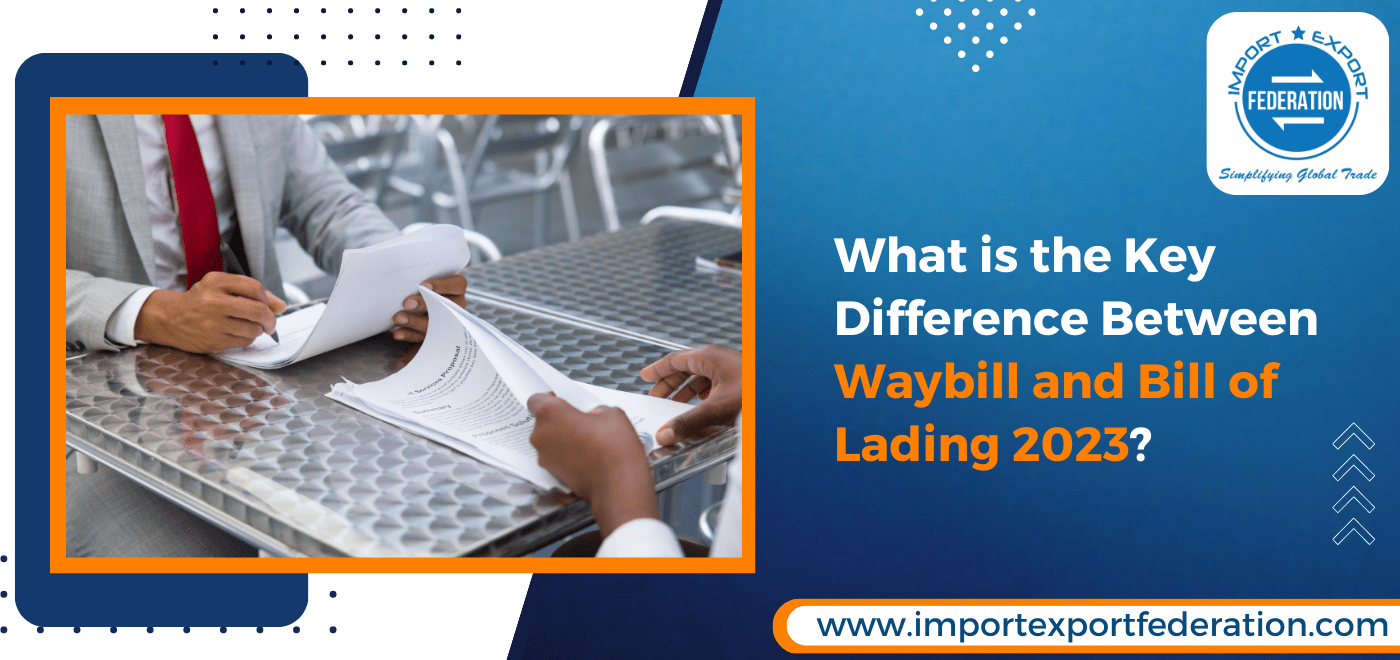Want to know the difference between bill of lading and waybill? Read on below!
Out of the countless paperwork, the 2 main documents used to ship your goods by sea are the bill of lading and waybill. People often get confused between the two, but they carry very specific functions while exporting. But that does not mean they are not related to each other! There is a big difference between waybill and bill of lading, based on where and why the 2 are used and needed.
To put it simply, the Bill of lading exists as a receipt of your export goods and a contract of transportation. On the other hand, a waybill stands as evidence of the bill of lading and that it is valid as a contract. Here is a detailed breakdown of the difference between waybill and bill of lading, and what each one do
Major Difference between Waybill and Bill of Lading:

1. Bill of Lading:
According to the U.N. Commission on International Trade Law, the transport of goods by sea requires a document called the Bill of Lading (B/L) to be provided as information, receipt, and contract about the transaction. The B/L can be issued by various parties involved in the shipping process, such as the carrier, transport agent, shipping company, vessel operator, or even the captain of the ship.
The B/L serves multiple important functions, including serving as a receipt for the goods being transported and confirming their apparent condition. It also serves as evidence of the contract of carriage and a document of title, transferring ownership of the goods to the holder, who may collect them from the carrier at the destination port.
Additionally, the B/L is considered a negotiable instrument and is accepted by banking institutions. The names of the shipper, the carrier, the exporter, the consignee, and the notify.
A Bill of lading needs the following information to be considered valid:
- The accurate name and address of the shipper
- The accurate name and address of the carrier
- The name and nationality of the vessel
- Unloading and loading final destinations
- The accurate name and address of the receiving entity or person of your goods
- The number of packages, their quantity, weight, and any identifying marks if any)
- INCOTERMS
- The number of original copies submitted
- The date, location, and signature of either the carrier, shipping company, vessel operator, or captain

2. WayBill:
A Waybill is a shipping document used to track the movement of goods during transportation. It contains information about the shipment, such as the origin, destination, and route, as well as details about the consignor and consignee.
The Waybill is used by the carrier, such as a shipping company or a trucking firm, to document the movement of the goods and to keep track of their progress. The Waybill typically includes the following information:
- The name and contact information of the consignor (the person or company sending the goods) and the consignee (the person or company receiving the goods).
- A description of the goods being shipped, including the type, quantity, and weight.
- The origin and destination of the shipment, along with the route that the goods will take.
- The date and time of pick-up and delivery.
- Any special instructions or requirements for the shipment, such as temperature controls, handling instructions, or customs requirements.
- It is important to note that the Waybill does not transfer ownership of the goods or serve as a receipt for the goods being transported. Instead, it is simply a document used to track the movement of the goods and to ensure that they are delivered to the correct place and at the right time.
- The Waybill is typically created by the carrier and can be an electronic document or a paper document. It is used in combination with other shipping documents, such as the Bill of Lading or the Delivery Order, to ensure a smooth and efficient transportation process.

Difference between Waybill and Bill of Lading: Are Both Necessary?
It depends on the specifics of the shipment. In general, a Bill of Lading (B/L) is considered to be the most important document for the shipment of goods by sea. As it outlines the terms and conditions of the transportation, including the description of the goods, their weight and volume, and the destination, it also confirms the receipt of the goods in good condition and serves as proof of ownership.
A Waybill, on the other hand, is used to track the movement of goods and to keep track of their progress during transportation. While it is not as comprehensive as the B/L, the Waybill is still useful in ensuring that the goods are delivered to the correct place and at the right time.
In some cases, both the B/L and the Waybill may be necessary for the shipment of goods. For example, the B/L may be required for the legal and financial aspects of the shipment, while the Waybill may be necessary for tracking and coordination purposes. Ultimately, the necessity of both documents will depend on the specific requirements of the shipment and the parties involved in the transportation process.
Conclusion
Now that you are aware of the difference between waybill and bill of lading, while also understanding the importance of both, you can learn how to acquire them both from the Import Export Federation. With online and offline courses that help you master the entire export cycle, right from product selection to documentation to finding buyers, to customs clearance, and finally shipping your goods, you get full support from the federation to export even if you are a beginner.
With our JNPT visit and Dubai Business Tour, you can visit actual markets and experience export practically while interacting with officials and importers from various countries. Start your export journey with us today!



 58,000+ Members
58,000+ Members  1,171+ Reviews
1,171+ Reviews 


